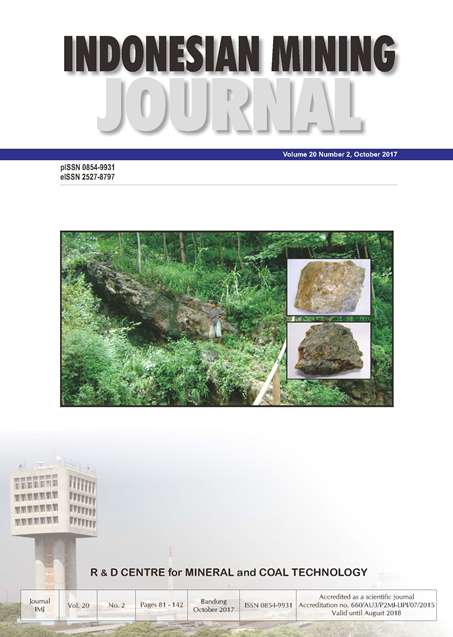FUZZY LOGIC APPROACH FOR POST-MINING LAND USE PLANNING: A CASE STUDY ON COAL MINE OF PT. ADARO INDONESIA-SOUTH KALIMANTAN
DOI:
https://doi.org/10.30556/imj.Vol20.No2.2017.371Keywords:
optimization, land use, post-mining, fuzzy logicAbstract
Currently coal companies, especially in South Kalimantan, have not yet been or only slightly entered the post-mining stage, although part of the mining blocks have been totally exploited, so that the company should have been preparing for the development of other sectors (non-mining). It shows that optimization of coal resources from exploration, mining to post-mining land use is necessary to ensure sustainable mining and sustainable development in terms of meeting the conservation aspect. To meet all aspects of conservation, the achievement of optimization in a series of mining business activities is started from the potential optimization of the coal remain resources until the optimization of post-mining land use is absolutely required. This research has analyzed several alternative sectors outside mining, which will be selected for optimization of utilization or post-mining land use, including plantation, recreation, industry and conservation sectors. The analyzing process used several parameters to assess the selected sectors including rainfall, slope and land use. Therefore, this study uses an approach of GIS-based methods (knowledge-driven), mainly fuzzy logic for post-mining land use planning. The selected mining area for this study belongs to PT. Adaro Indonesia company that has a Work Agreement for Coal Mining Exploitation. The result shows the suitability of plantation for the optimization of land use in all mining sites and also for conservation areas or protected forests.
References
Badan Pusat Statistik (2014) Kabupaten Balangan dan Tabalong dalam angka 2014. Paringin.
Bonham-Carter, G. F. (1994) “Modelling with GIS,” in Geographic information systems for geoscientists. 1st Editio. Pergamon, p. 416. Available at: https://www.elsevier.com/books/geographic-information-systems-for-geoscientists/bonham-carter/978-0-08-041867-4.
Craynon, J. R. (2011) Approaches and barriers to incorporating sustainable development into coal mine design. Virginia Polytechnic Institute. Available at: https://vtechworks.lib.vt.edu/bitstream/handle/10919/29660/Craynon_JR_D_2011.pdf?sequence=1&isAllowed=y.
Directorate General of Mineral and Coal (2014) Dokumen kegiatan tahunan (RKAB dan RKTTL) perusahaan PKP2B di Prov. Kalimantan Selatan. Jakarta.
Foroutan, E. and Delavar, M. (2012) “Urban growth modeling using fuzzy logic,” in Annual Conference Sacramento California. New York: American Society for Photogrammetry & Remote Sensing, pp. 154–163. Available at: https://www.asprs.org/conference-proceedings/sacramento-2012-asprs-annual-conference-proceedings.html.
Hao, Y., Wu, Y., Zhang, S. and Chen, L. (2013) “Integrated Evaluation of Ecological Sustainability of a Mining Area in the Western Region of China,” International Journal of Environmental Science and Development, 4(2), pp. 196–201. doi: 10.7763/IJESD.2013.V4.334.
Liu, H., Ye, C. and Qi, X. (2012) “Study on developing coal resource with the social-economic influence in Erdos City,” Cross-Cultural Communication, 8(6), pp. 112–117. doi: 10.3968/j.ccc.1923670020120806.2415.
Luppens, J. A., Rohrbacher, T. J., Osmonson, L. M. and Carter, M. D. (2009) Coal resource availability, recoverability, and economic evaluations in the United States-A Summary, The National Coal Resource Assessment Overview. Denver, Colorado. Available at: https://pubs.usgs.gov/pp/1625f/downloads/ChapterD.pdf.
Nugroho, A. and Hartati, S. (2012) “Sistem pendukung keputusan berbasis logika fuzzy untuk penentuan kesesuaian penggunaan lahan (Studi kasus : Kabupaten Semarang),” Jurnal Aristoteles, 9(2), pp. 1–14.
Setiabudi, B. T. and Hutamadi, R. (2003) “Kebijakan konservasi bahan galian dalam pengelolaan sumberdaya mineral di Indonesia,” in Kolokium Hasil Kegiatan Inventarisasi Sumberdaya Mineral-DIM. Bandung: Pusat Sumber Daya Geologi, p. 5.1-5.10. Available at: http://psdg.bgl.esdm.go.id/kolokium 2003/konservasi/Proc KEBIJAKAN-Bambang.pdf.
Sharma, P. D. (2011) Bringing sustainability in coal mining operations is need-of-the-hour, www.issuu.com. Available at: https://issuu.com/sharmapd1/docs/bringing_sustainability_in_coal_mining_operations (Accessed: August 10, 2017).
Shields, D. J. (2007) “The contributions of geologic information to economic, social, and environmental sustainability,” in Proceedings for a Workshop on Deposit Modeling, Mineral Resource Assessment, and Their Role in Sustainable Development. Reston, Virginia: U.S. Geological Survey Circular 1294, pp. 17–18. Available at: https://pubs.usgs.gov/circ/2007/1294/reports/paper2.pdf.
Suyartono (2004) Good mining practices: Konsep tentang pengelolaan pertambangan yang baik dan benar. Semarang: Studi Nusa.
Wang, X. and Zhang, G. (2008) “Study on the sustainable development of Henan coal industry under the guide of circular economy,” in International Conference on Management Science and Engineering. ST.PLUM-BLOSSOM PRESS PTY.LTD., pp. 659–663. Available at: http://www.seiofbluemountain.com/upload/product/200910/2008glhy07a7.pdf.
Downloads
Published
Issue
Section
License
Indonesian Mining Journal provides immediate open access to its content on the principle that making research freely available to the public to supports a greater global exchange of knowledge.

This work is licensed under a Creative Commons Attribution-NonCommercial 4.0 International License.













